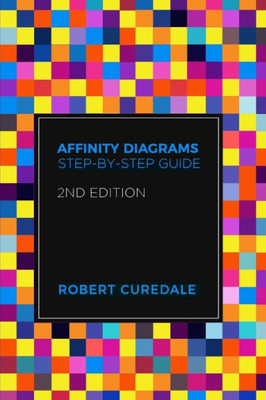

Affinity Diagrams: Step-by-Step Guide 2nd Edition
Design Community College Inc.
ISBN13:
9781940805504
$26.09
The problems that designers are addressing are becoming more complex. Designers and managers are processing more information to reach better decisions. Affinity diagrams are one of the best tools to go from data chaos and being overwhelmed with too much information to identifying the best solution to a problem. Affinity diagrams help prioritize actions and improve group decision-making . Whether you're brainstorming ideas, or dealing with lots of information from a variety of sources, you can struggle to make sense out of the information. A brainstorming session or a series of customer interviews may generate hundreds of ideas or pieces of data. They can help you process large bodies of information, facts, ethnographic research, ideas from brainstorms, user opinions, user needs, and insights. An affinity diagram is one of the most efficient ways of deciding what is most important so that a favored design solution can then be prototyped and tested. Affinity diagrams, sometimes called the KJ method, are one of the most useful tools for organizing information or ideas into groups so that effective and efficient decisions can be made. The word "affinity refers to the natural connections among ideas. The method was first developed by Kawakita Jiro a brilliant Japanese anthropologist in the 1950s and 1960s. It may be the single most significant advance in design practice made in design over the last half century. Without affinity diagrams it would be difficult to work in any environment where designers need to make sense of complex data. The Japanese Union of Scientists and Engineers consider affinity diagrams one of the "seven key management tools" used in Total Quality Control in Japan. From the chaos of the randomly generated ideas emerge insights into the connections and significance of ideas. The affinity process is one of the best ways of making sense of ideas generated during a brainstorming session. This tool can be used in any phase of the design process. Two common uses are problem and solution identification. It is also often used in contextual inquiry to process research data and insights from field interviews. It can be used for synthesizing survey responses or other research data. Affinity diagrams encourage full team participation in the development of more people-centered solutions. They can be used in any situation where the solution is not initially apparent or where you want to reach a consensus and have a lot of variables to consider. Here is a step-by-step guide to using affinity diagrams. I hope that you will find it useful.
- | Author: Robert Curedale
- | Publisher: Design Community College Inc.
- | Publication Date: Mar 10, 2019
- | Number of Pages: 155 pages
- | Language: English
- | Binding: Paperback
- | ISBN-10: 1940805503
- | ISBN-13: 9781940805504
- Author:
- Robert Curedale
- Publisher:
- Design Community College Inc.
- Publication Date:
- Mar 10, 2019
- Number of pages:
- 155 pages
- Language:
- English
- Binding:
- Paperback
- ISBN-10:
- 1940805503
- ISBN-13:
- 9781940805504





